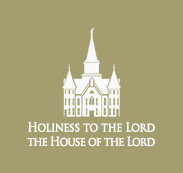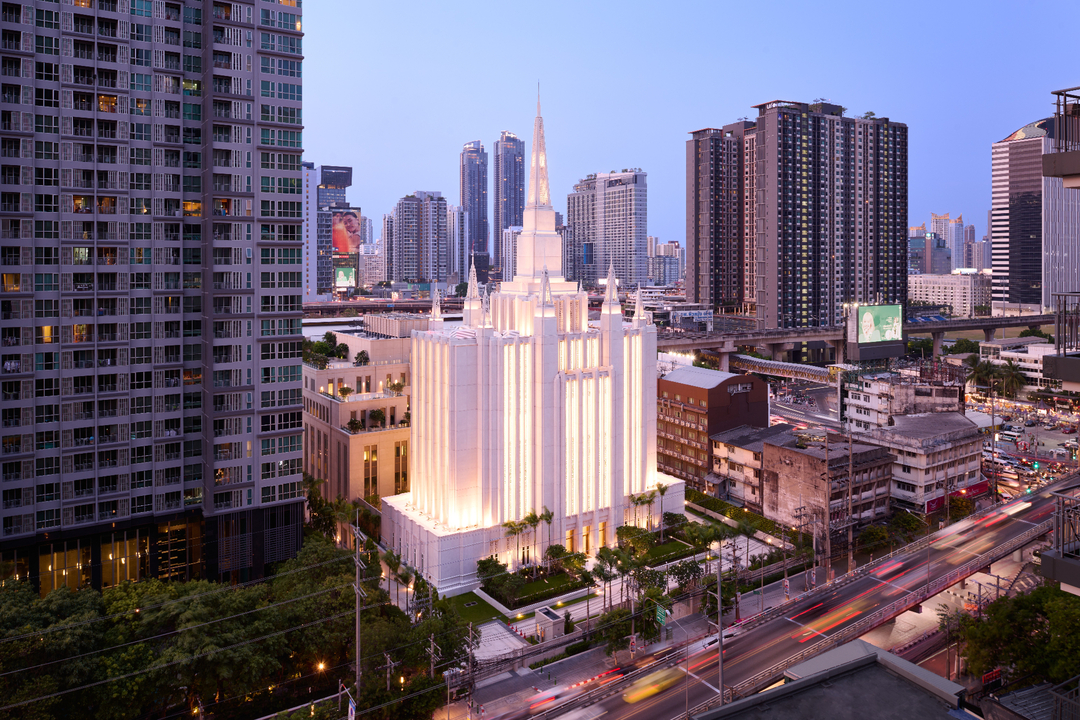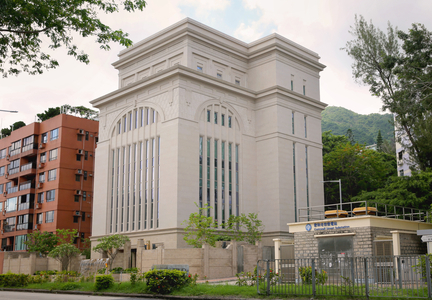Address
1645/6 New Petchaburi RoadMakkasan
Ratchathewi
Bangkok, 10400
Thailand
Telephone: (+66) 02-021-7200
Services
NO visitors' center open to the publicArrival center available
Patron housing available
Distribution center on site (Store Locator)
Announcement:
5 April 2015Site Dedication:
26 January 2019 by David F. EvansGroundbreaking:
26 January 2019 by Robert C. GayPublic Open House:
1–16 September 2023Dedication:
22 October 2023 by Ronald A. RasbandSite:
1.77 acres | 0.7 hectaresExterior Finish:
Precast concrete panels fabricated by Asia Group of Chom Thong, BangkokArchitectural Features:
Central spire surrounded by eight smaller spiresOrdinance Rooms:
Two instruction rooms, two sealing rooms, and one baptistryTotal Floor Area:
48,525 square feet | 4,508 square metersHeight:
242 feet | 73.8 metersElevation:
12 feet | 4 metersTemple Locale
The design of the Bangkok Thailand Temple follows the patterns and colors found within Thai architecture. Many of these patterns overlay various diamond shapes with lotus flower elements and a herringbone pattern, evoking the weaved palms used in traditional arts and goods. With the combination of the screened spires and windows, the temple forms a beautiful silhouette in the Bangkok skyline. A Christus statue stands in the courtyard that connects the temple to the annex building. The annex stands behind the temple and houses the Thailand MTC, two meetinghouses, a service center, seminary and institute offices and classrooms, and mission offices and housing.
Temple Facts
The Bangkok Thailand Temple was the first temple built in mainland Southeast Asia.
Although the original rendering of the Bangkok Thailand Temple featured a statue of the angel Moroni atop the center spire, it was later removed from the design.
Temple History
Background
On June 12, 2000, President Gordon B. Hinckley became the first president of the Church to visit Thailand where he enjoyed a "pre-birthday" celebration hosted by Deputy Prime Minister Bhichai Rattakul. The next morning, President Hinckley also met with Bangkok Governor Bhichit Rattakul and Thailand Prime Minister Chuan Leepkai who thanked the prophet for all the work that Church volunteers had rendered for Thailand, noting in particular the 100 volunteers who had taught more than 300,000 English teachers and students over the previous three years.
Bangkok was the second stop in a tour of Asia and the South Pacific to dedicate four temples in Fukuoka, Japan; Adelaide, Australia; Melbourne, Australia; and Suva, Fiji. Before leaving Bangkok, President Hinckley addressed a congregation of over 2,600 members at the Thailand Air Force Convention Center. Some members had traveled 18 hours by bus to be in attendance.
In his remarks, President Hinckley recalled his first visit to the country in 1961 when there were just a half dozen members of the Church. By 1966, President Keith E. Garner of the Southern Far East Mission had organized the Thailand District, and President Hinckley returned in November of that year to dedicate modern Thailand for the preaching of the gospel. "We went quietly in the morning into Lumpini Park, a small group of us, including Elder Marion D. Hanks of the Seventy, and there we lifted our voices in prayer. We prayed that the Lord would smile upon this land, that He would touch it by the power of His Holy Spirit, that the way would be opened for missionaries to come here, that the faithful would accept the truth, and that the Lord would do a great and good work here." He continued, "Now it's been a long time since I was here and I have seen a miracle, a very real miracle." He told the members that they were pioneers of the Lord's work in their country and promised that if they were faithful, the time would come when a temple would be constructed in Thailand. "The Lord expects so very, very much of you. He expects you to be the best people in all of Thailand, and you ought to be because you have a knowledge of His everlasting truth."1
Announcement
President Thomas S. Monson announced the construction of the Bangkok Thailand Temple during his opening remarks at the Sunday Morning Session of the 185th Annual General Conference. The temple would be the first in Thailand where the Church was formally organized in 1966. At the time of the announcement, there were approximately 18,000 Church members in 38 congregations in Thailand. The temple would serve Latter-day Saints throughout Southeast Asia who belonged to the Hong Kong China Temple district.2
Nearly twenty years after the first stake was organized in Bangkok in 1995, the city's second stake was organized on June 15, 2014, and its third on November 27, 2016. The first stake in Thailand outside of Bangkok was organized in Ubon on June 14, 2015. Two other districts operated in the country, headquartered in Chiang Mai and Udorn, which were expected to be reorganized as stakes in the coming years.
Site
The Bangkok Thailand Temple was constructed on the site of a former Church office building on New Petchaburi Road, acquired by the Church in 2008. The Makkasen Station on Bangkok's Airport Rail Link stands directly behind the property, making for rapid and dependable transportation from Suvarnabhumi Airport, which opened in 2006. The office building once housed most of the country's Church offices including the Thailand Bangkok Mission, the Bangkok Thailand Service Center, the Bangkok Thailand PEF Self Reliance Center, and LDS Charities.
Rendering
On March 19, 2018, an artistic rendering of the Bangkok Thailand Temple was released to the public, revealing a 44,405-square-foot, six-story building with a soaring central spire and eight smaller surrounding spires. Behind the temple, an additional 91,370-square-foot Church facility would be constructed housing two meetinghouses, a service center, seminary and institute offices and classrooms, and mission offices and housing. An extensive underground parking structure was also planned for the site.
Speaking of the temple, President Russell M. Nelson said: "The Bangkok Temple will be a blessing to all the people of this area. It will be a symbol of faith to tens of thousands of members of the Church throughout the region and their commitment to follow Jesus Christ. It will also stand as a reminder that God loves and cares for all of His children. All we do in the Church points to the Lord and His holy house."3
Groundbreaking
Elder Robert C. Gay of the Presidency of the Seventy was joined by Church and community leaders on Saturday, January 26, 2019, to break ground for the construction of the Bangkok Thailand Temple. Elder David F. Evans, president of the Asia Area, offered the site dedicatory prayer to an audience of 700 members with many more joining by broadcast at Church meetinghouses. "For more than 50 years, the faithful saints in Thailand have waited and prayed for this day," said Elder Evans. "The construction and ultimate completion of the temple will become a blessing for not only the members of the Church, but also for all who see the beauty of the temple and feel of the peace that will be found on this sacred ground."
Sister Wipharat Uanphoklang, who also offered remarks during the service, has lived the gospel faithfully with her husband and three sons. She shared the feelings of many Thai members when she said: "We have long prayed for a temple in Thailand. We are grateful that each of our children will have the blessing of receiving their temple ordinances and being sealed when they go on missions and marry. The temple gives us joy and hope as we seek to teach our children and help them feel of God’s love for them."4
Open House and Dedication
The public open house for the Bangkok Thailand Temple was held Friday, September 1 through Saturday, September 16, 2023, with no tours held on Sundays. Elder Ronald A. Rasband of the Quorum of the Twelve Apostles dedicated the temple on Sunday, October 22, in two sessions broadcast to all units in the temple district held at 10:00 a.m. and 1:30 p.m. A media day preceded the public portion of the open house on Monday, August 28, followed by three days of tours for invited guests.5
Temple Design
Exterior
The temple is a cast-in-place concrete structure with a precast concrete skin. The spires are cast glass-fiber-reinforced concrete. The precast concrete was fabricated by Asia Group (1999), located in Chom Thong, Bangkok.
The temple has nine spires of varying size. Each is capped with a perforated decorative screen designed to blend seamlessly with the heavens above and provide a glowing ember at night. The Bangkok temple does not feature an angel Moroni statue.
Decorative screens are a common design element throughout Asia. The exterior art glass’s outer layer has a silk screen interlocking octagonal pattern. The inner layer uses the same pattern with frosted carved glass and an amber, gold, and teal border. The art glass was designed by the Richardson Design Partnership group. It was fabricated by Glass Images & Creations Inc., located in Orem, Utah.
The water features were designed by Brian Anderson with Water Design Inc., located in Murray, Utah. The fountains were installed by S.Napa (Thailand), located in Bangkok, Thailand. The installation was designed by ME49 of Bangkok, Thailand.
The landscape was designed by Loci LLC, located in Salt Lake City, Utah. Trees, shrubs, and perennials were carefully selected to beautify and soften the temple grounds.
The south fence repeats the geometric pattern found on the temple spires and art glass. The patterns in the plazas also reflect the lotus design found on the temple facade. The fence was fabricated and installed by Premier Products of Bang Kapi District, Bangkok. The walkway was fabricated and installed by Thong Heng Stone Product and Stone Center, located in Bangkok, Thailand.
Interior
The temple’s carpet was designed and fabricated by Bentley Mills in City of Industry, California. The white rugs were designed by Richardson Design Partnernship and manufactured by Rugs International of Cartersville, Georgia. Other carpeting was manufactured by Bentley Mills Inc. The stone flooring is Sunny Venato quarried by Primo Stone of Egypt and laid in a herringbone pattern. The stone fabricator was Empire Granite, located in Saraburi, Thailand, and the installer was Mutiara, located in Pathum Thani, Thailand.
The interior’s decorative paint was designed by the Richardson Design Partnership group. The decorative subcontractor was Tanyarin Decoration of Bangkok, Thailand. Decorative paint is used in all ordinance rooms in the temple.
The interior art glass was designed by the Richardson Design Partnership group and fabricated by Glass Images & Creations Inc.
The form of the decorative light fixtures was inspired by royal sun umbrellas, but their function is inverse: instead of providing shade, they radiate light. The fixtures were designed by the Richardson Design Partnership group and fabricated by Ciana Lighting of Heber City, Utah.
Carved details on the celestial and sealing room columns feature ratchaphruek tree flowers, which are Thailand’s national flower. Millwork was fabricated and installed by Tanyarin Decoration.
The baptismal font railings were fabricated and installed by Thapanin of Samut Prakan, Thailand. The font’s art glass was fabricated and installed by Glass Images & Creations Inc.
The decorative door hardware is machine-milled bronze. It was fabricated by Arte Hardware of Johns Creek, Georgia. Doors with a lever handle feature a lotus flower motif.
Wall coverings used in the bride’s room were manufactured in Bangkok, Thailand.
All the ceilings in the temple are constructed of gypsum board with crown molding. The profile of the crown molding is inspired by the curvy movements of Thai design. The ceilings were fabricated and installed by Mutiara.
Church History in Thailand
In 1852, Brigham Young, the President of The Church of Jesus Christ of Latter-day Saints, sent four missionaries to Thailand, then known as Siam. Only one of them made it to the country, and not until 1854, and he stayed only four months due to the language barrier.
In the 1950s, various member families living in Bangkok held informal Church services intermittently. A small English-speaking congregation has functioned continually since 1961, when the Church authorized regular worship services.
On November 2, 1966, Elder Gordon B. Hinckley of the Church’s Quorum of the Twelve Apostles dedicated Thailand for the preaching of the gospel. Church leaders met at 6:30 a.m. in a quiet area of Lumphini Park in the heart of Bangkok and held a brief service. The Thailand District of the Church had been organized earlier that year, and missionaries were transferred to the area in 1968, ensuring that membership would grow.
In 1973, Thailand became its own mission. The next year, the first chapel was dedicated, built in a small alley off Asoke Montri Road in Bangkok.
A missionary singing group called Sidthichon Yuk Sud Tai (“The Latter-day Saints”) was created in 1975. They toured the country, performing in front of thousands, blending Western and Thai sounds. The group raised money for charities and programs such as the Thai International Red Cross, Bangkok Teachers College, hospitals, and a drug rehabilitation program. They received an invitation to perform at the king’s charity event and even met the king and queen afterward.
During its more-than-four-year-long existence, the group appeared on TV over 70 times, recorded five albums, performed for royalty three times and did over 500 live performances for more than 1 million people in all of Thailand’s major cities.
Church membership continued to grow throughout Thailand. In 1987, three new meetinghouses were dedicated in Bang Na, Thon Buri, and Chiang Mai, and in June 1995 the Bangkok Thailand Stake (similar to a diocese) was created. Almost 20 years later, in 2014, a second stake was created in Bangkok, and in late 2016 came a third Bangkok stake.
From that small beginning, Church membership in Thailand grew to what now exceeds 23,000, with chapels throughout Bangkok and most large urban centers in the country, including Chiang Mai, Nakhon Ratchasima, Khon Kaen, Udon Thani, and Ubon Ratchathani.
To the joy of members of the Church in Thailand, it was announced in April 2015 that a temple would be constructed in Bangkok. Temples are sacred buildings where members can receive great blessings and perform special ordinances on behalf of their ancestors.
The temple compound includes an annex building, which houses Church offices and two separate chapels and meeting rooms. The annex will also have a FamilySearch center, which will be open to all people in Thailand to help research their family genealogies.
A groundbreaking ceremony for the Bangkok Thailand Temple was held on Jan. 26, 2019. Construction is now complete, and members of the community are invited to an open house Sept. 1–16 (excluding Sundays) before the temple is dedicated on Oct. 22, 2023.
During his visit to Bangkok in April 2018, Church President Russell M. Nelson told Thai members: “My desires for the people of Thailand [are] the same as my desires for people [of] any other city [or] country. We invite all of God’s children … to come unto the Savior and enjoy the blessings and benefits of their temple and have everlasting life [and] joy.”
- "'We have been on a long journey—but it was a great occasion,'" Church News 1 Jul. 2000, 27 Aug. 2010 <http://www.ldschurchnews.com/articles/38065/We-have-been-on-a-long-journey--but-it-was-a-great-occasion.html>.
- "New Temples Announced: Abidjan, Ivory Coast (Côte d’Ivoire); Port Au Prince, Haiti; Bangkok, Thailand," The Church of Jesus Christ of Latter-day Saints News Release, 5 Apr. 2015.
- "Artistic Rendering of Bangkok Thailand Temple Released," The Church of Jesus Christ of Latter-day Saints News Release, 19 Mar. 2018.
- "Church Leaders Break Ground for Temple in Bangkok," The Church of Jesus Christ of Latter-day Saints News Release, 25 Jan. 2019
- "News for Temples in Five Nations," The Church of Jesus Christ of Latter-day Saints News Release, 27 Mar. 2023.


